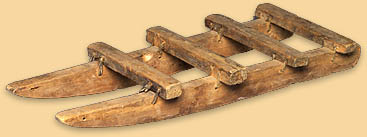|
Playthings, as anthropologist Christian Leden calls them, were among
the few objects created during the contact-traditional period which were
not of strictly utilitarian use.
Hawkes notes: "Small children are provided by admiring relatives
with small ivory carvings of animals and birds, with which they play by
the hour, arranging them for various plays and hunts"
(Hawkes, p.113).
Lucien Turner, who travelled in the Ungava region between 1882 and
1884, refers to ivory carvings which he collected as toys. "These
carvings are fashioned from the tusks of the walrus or the teeth of
various large mammals, and are simply tests of the skill of the worker
who prepares them as toys for the children"
(Turner, p.96).
Bishop Fleming describes a young Inuit couple: "As children came
to bless their union it was touching to see Pudlo watch over them with
tenderest care, carving them toys from bits of wood and ivory ...]
(Fleming, p.137).
Fleming, Archibald Lang
1956 – Archibald the Arctic. New York: Appleton-Century-Crofts,
Inc.
E. W. Hawkes
1916 – The Labrador Eskimo. Ottawa: Government Printing
Bureau, (Geological Survey of Canada) Memoir 91; Anthropological
Series, No. 14.
Leden, Christian
1. Across the Keewatin Icefields. Winnipeg: Watson and Wyer
Publishing Ltd.
Turner, Lucien
[1894] 1979 – Indians and Eskimos in the Quebec – Labrador
Peninsula. Ethnology of the Ungava District, Hudson Bay Territory.
Quebec: Presses Comiditex.

"Kajak – Plaything," 1915
Area around Chesterfield Inlet, Nunavut
Bone
3 x 11.8 x 6.3 cm
CMC IV-C-1228
Collected by Danish anthropologist Christian Leden
during his expedition
to the Keewatin from 1913 to 1916
|
 |
This highly stylized hunter in a kayak would have been a toy for a
boy. An object on the same theme, if designed as an item for barter for
tobacco and other trade goods, would have been much more detailed.
 "Kammutit – Sled (Plaything)," 1915
"Kammutit – Sled (Plaything)," 1915
Chesterfield Inlet area, Nunavut
Wood, string
4.3 x 36 x 13.7 cm
CMC IV-C-1018
Collected by Danish anthropologist Christian Leden
during his expedition
to the Keewatin from 1913 to 1916
|
 |
Toys also had an educational function. Hawkes observed: "As the
child grows up, it plays at the work of its elders. The girl helps her
mother around the house or plays with her dolls and miniature house and
utensils .... The boys early receive small harpoons and bows and arrows
and try their skill on small birds and floating pieces of wood."*
This particular toy would teach a boy about the construction of sleds.
E. W. Hawkes
1916 – The Labrador Eskimo. Ottawa: Government Printing
Bureau, (Geological Survey of Canada) Memoir 91; Anthropological
Series, No. 14, p. 113.
|